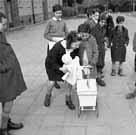
|
|
|

|

|

|

|
|
Click on an image to see a larger, more detailed picture.
|
|
|
|
|
| 1945: Liberation and Rebuilding |

|
pg. 606 |

|
|
|
|
| |
 These children, survivors of the Bergen-Belsen, Germany, camp, play with toys seized from surrounding towns by Allied soldiers. With about six million Jews murdered during World War II, it is probable that most of these children were orphans who had no place to go. Such scenes were not unusual; a large percentage of the inhabitants of the displaced-person camps were children and adolescents.
These children, survivors of the Bergen-Belsen, Germany, camp, play with toys seized from surrounding towns by Allied soldiers. With about six million Jews murdered during World War II, it is probable that most of these children were orphans who had no place to go. Such scenes were not unusual; a large percentage of the inhabitants of the displaced-person camps were children and adolescents.
Photo: Imperial War Museum
|
 As the end of the war drew near, the Nazis moved tens of thousands of prisoners to camps in the heart of Germany. This skeletal young woman, who had been in the women's camp in Ravensbrück, Germany, was among thousands of inmates shipped to Sachsenhausen in the spring of 1945. Thousands of prisoners died on these journeys, which have justifiably become known as "death marches."
As the end of the war drew near, the Nazis moved tens of thousands of prisoners to camps in the heart of Germany. This skeletal young woman, who had been in the women's camp in Ravensbrück, Germany, was among thousands of inmates shipped to Sachsenhausen in the spring of 1945. Thousands of prisoners died on these journeys, which have justifiably become known as "death marches."
Photo: Ministere des Anciens Combattants
|
|
African-Americans at the Camps The Allies' liberation of the disease-infested and horribly overcrowded concentration camps in Germany was a bittersweet experience. For African-American soldiers, seeing victims of racism--dead, dying, or suffering--was a frightening reminder of the potential consequences of prejudice. While nothing could have prepared anyone for what lay behind the gates of Dachau and Buchenwald, African-American soldiers seemed particularly affected by what they witnessed. Bob Bender, a survivor liberated from Buchenwald, recalls the "black soldiers of the U.S. Third Army, tall and strong, crying like babies, carrying the emaciated bodies of the liberated prisoners." Awestruck by what he had seen at Buchenwald, Leon Bass of the 183rd Combat Engineer Battalion of the U.S. Third Army offered this powerful observation: "I came into that camp an angry black soldier. Angry at my country and justifiably so. Angry because they were treating me as though I was not good enough. But [that day] I came to the realization that human suffering is not relegated to me and mine. I now knew that human suffering could touch us all....[What I saw] in Buchenwald was the face of evil...it was racism."
|
|

|

|

|

|
 April 15, 1945: At Ravensbrück and Sachsenhausen, Germany, 57,000 inmates--17,000 of them women--are marched westward by the SS. Once under way, many will be shot and/or die of exhaustion, and others, including 21-year-old Mila Racine, will be killed during Allied bomb attacks aimed at nearby targets.
April 15, 1945: At Ravensbrück and Sachsenhausen, Germany, 57,000 inmates--17,000 of them women--are marched westward by the SS. Once under way, many will be shot and/or die of exhaustion, and others, including 21-year-old Mila Racine, will be killed during Allied bomb attacks aimed at nearby targets.
|
 April 15, 1945: A deportation train from Vienna, the final one organized by Adolf Eichmann's staff, arrives at the Theresienstadt, Czechoslovakia, camp/ghetto with 109 Jews.
April 15, 1945: A deportation train from Vienna, the final one organized by Adolf Eichmann's staff, arrives at the Theresienstadt, Czechoslovakia, camp/ghetto with 109 Jews.
|
 April 15-17, 1945: A small contingent of British troops at the Bergen-Belsen, Germany, camp is unable to prevent Hungarian SS guards from murdering 72 Jewish and 11 non-Jewish prisoners.
April 15-17, 1945: A small contingent of British troops at the Bergen-Belsen, Germany, camp is unable to prevent Hungarian SS guards from murdering 72 Jewish and 11 non-Jewish prisoners.
|
|
|
|
|
| 1945: Liberation and Rebuilding |

|
pg. 606 |

|
|
The Holocaust Chronicle
© 2009 Publications International, Ltd.
|
|
